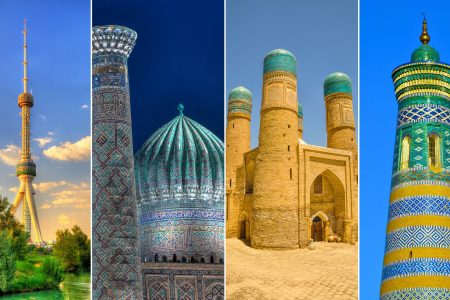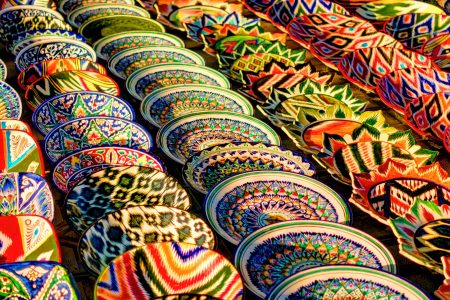The fabulous city of Khiva, the city of “Thousand and One Nights”, has surprised local and foreign tourists for centuries with its unique beauty and charm. Ogni volta che si visita questa città e si passeggia per le sue antiche strade e gli edifici storici circostanti, si ha la sensazione di tornare ai tempi passati. An “open-air museum” status was given to Khiva as it is one of the few cities in the world where an entire open-air city has been preserved in the form of old historical landmarks as a result Khiva turned to one of the most popular international touristic destinations. In addition to that more than 122 archaeological iconic statues and architectural landmarks related to the 6th to the 5th centuries BC till the beginning of the 20th century have been preserved in the old city and protected by Government. Nei suoi monumenti si possono osservare le più belle opere degli artisti popolari dell’oasi di Khorezm * (Khiva fa parte della regione di Khorezm). In particular, Ichan-Kal`a (Internal castle) part of Khiva is the only preserved old city in the Central Asia, its fate in the past, its architectural monuments are closely connected with the historical and cultural development of Khorezm oasis.
Khiva è un’antica città-museo aperta e considerata un’area residenziale, proprio come Roma, Granada e altre città storiche. Consequently, it influence positively to the local and foreign tourists by letting them to observe alive old city with the huge interest. Uno dei più antichi musei dell’Uzbekistan, il Museo storico-architettonico statale di Khiva “Ichan-Kala”, ha un’area di 26 ettari ed è stato avvolto dalle antiche mura di “Ichan-Kala”.
Khiva is the first city in Central Asia to be included in the World Heritage List by a special resolution of the 14th session of UNESCO in Canada on December 12, 1990. I ricercatori archeologici hanno affermato che la città ha più di 2.500 anni. Anche Erodoto, noto come “il padre della storia”, ha riportato alcune informazioni su Khorezm e i khorezmiani nei suoi romanzi.
Nel Medioevo, Khiva era una città di scienziati e studiosi. There had been carried out numerous experiments and discoveries for the development of astronomy, mathematics, and medicine by great scientists Abu Raikhan Beruni, Abu Ali ibn Sino (Avisenna) in the large centers of science. Mamun Academy was established and researches were carried out by the greatest oriental scientists and scholars during the timeline of King Mamun ibn Muhammad. Famous poets of the 19th century Shermuhammad Munis and Ogahi created their novels in this city. È inoltre fondamentale ricordare che un altro grande scienziato, cresciuto nella regione di Khorezm, ha fondato una scienza che ha avuto un ruolo enorme nello sviluppo dell’umanità. This scientist was the famous Abu Abdullah Muhammad ibn Musa al-Khwarizmi, who founded the science of algebra, and this term is well known from his book “A Brief Book on Algebraic Calculus”. Apparently, the word “ algebraic ” comes from the word of “algebra” and every one knows about it.
Durante il suo periodo di fioritura, Khorezm era il più grande centro del commercio internazionale e una parte fondamentale della Grande Via della Seta. I mercanti provenienti dalla regione del Volga, dall’India e dall’Iran giungevano in questa città e viaggiavano verso il Medio Oriente, il Turkestan orientale e la Cina con le carovane. Diverse rotte commerciali da Khiva conducevano in Mongolia, attraverso le steppe del Kazakistan, a Saksin, una città commerciale sul Volga, e da lì ai principati russi e all’Europa.
In effetti, la regione di Khorezm, in particolare la città di Khiva, è considerata un luogo unico e sacro nel mondo turco. In 2019 on November 30, at the 37th meeting of the Permanent Council of the International Organization of Turkish Culture – TURKSOY, Khiva was declared the cultural capital of Turkish world in 2020.



